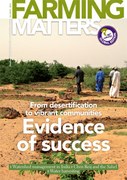During the past 27 years, our magazines have shown many of the ways in which farmers and organisations are fighting desertification. Combined with scientific knowledge, the approaches based on farmers’ ancestral knowledge and inventiveness can make a real difference, helping to conserve natural resources and give high yields. A quick review of the hundreds of articles published by the AgriCultures Network shows some aspects worth highlighting.
Indigenous species and knowledge
Old magazine coversDesertification is a global problem, and governments and civil society organisations are increasingly taking efforts to combat it. However, many of the plans and strategies that are drafted simply ignore the traditional knowledge of those living in the world’s drylands. Our different magazines have published articles that highlight the importance of this knowledge in the fight against desertification.
For instance, in the Philippines, many farmers use indigenous trees and shrubs on or near crop fields, as Blesilda M. Calub showed in an article published on the December 2003 issue of our global edition. “Farmers are easily motivated to plant certain species, such as fodder trees and shrubs that directly address their needs.” In the south-western region of the Philippines, selling livestock provides an important source of income for many farmers, so the availability of fodder is very important for them. The use of indigenous trees provides the necessary fodder, and also helps to alleviate degradation.
Similar efforts can be seen in Rajasthan, India, where farmers follow traditional agroforestry practices, as described by M. Nagarajan in the LEISA India issue of March 2000. Their management involves delicately combining woody components (including trees, shrubs or bamboos) with agricultural crops. One very special species, considered by some farmers as “a foster mother to agriculture”, is the Khejri tree (Prosopis cineraria). Observation and experimentation has shown that crops grown under the canopy of this tree fare better than those growing under similar conditions without trees.
Soil and water management
The importance of soil and water conservation in drylands can hardly be underestimated. In Brazil’s north east, which has a dry climate and is experiencing increased levels of deforestation, water access is of great importance for the community.
J.A. Soccal’s article, published in the March 2000 issue of LEISA Magazine, shows how, dissatisfied with “assistentialist” approaches from the government, such as the distribution of water in trucks, the local community enlisted the support of different NGOs and other CBOs (community- based organisations). This led them to develop alternative technologies for managing their water resources, all of them inexpensive and based on local materials and labour. These include building plate cisterns to collect rainwater for human consumption, semi-permeable wells either under or across seasonal river beds or along drainage lines to retain groundwater; and wells that use a simple system of pulleys and pipes.
In another article written for LEISA revista de agroecología (September 2008), Héctor Leguía described his work with scientists and farmers in Lozada, in Argentina’s semi-arid region. Soybean cultivation in this area was causing several problems in the fields, with declining levels of fertility, compression and contamination by pesticides. The scientists worked together with the area’s family farmers exploring techniques, built around an agro-ecological approach, to improve the soil and contribute to its conservation. Techniques such as crop rotations and cover crops significantly increased the amount of organic matter in the soil and enhanced its physical properties, which had a direct effect on farmer’s yields.
Co-operation
In the April 2009 issue of Agriculturas, Carlos Magno Morais presented the work of three NGOs collaborating with farmers in the states of Pernambuco and Rio Grande do Norte, Brazil. These NGOs collected the farmers’ opinions and ideas about the effects and influence of climate change in their day-to-day activities, and described and analysed their responses. This led to the publication of documents that have been used in the preparation of the National Action Plan to Combat Desertification (PAN Brasil) and to build farmers’ understanding about sustainability.
In another article, published in our global edition (September 2008), Paul Van Mele showed the benefits of people working together in Zamblara, a village in Mali. Most inhabitants in this village rely on agriculture and face many difficulties, such as a lack of seeds, credit or water. In 2002 a group of women formed a rice producers’ organisation. They approached the Africa Rice Center (WARDA), interested in participating in the training activities under the Participatory Adaptation and Diffusion of Technologies for Rice-based Systems (PADS) project. The group grew from 27 people to more than one hundred, all benefitting from the project’s activities which led them to diversify their cropping diversification, a strategy that provided higher yields and incomes. These farmers now grow more rice and manage local resources in a more sustainable way. Equally important is their recognition of the importance of working together. Caste and gender differences are becoming less-pronounced, and the solid partnerships created with NGOs and government agencies lead to better decisions. As mentioned by one of the farmers, “the future belongs to organised people”. (HT)

